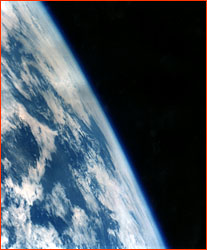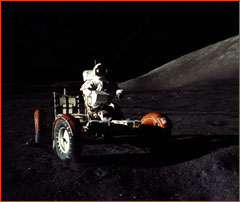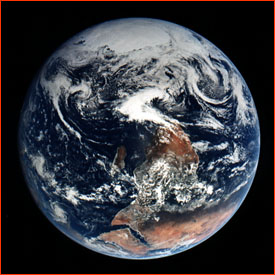
|
 |
 |
by Peter Tyson Whence our moon? Was it a chunk of Earth flung off in our planet's early history? Did the Earth capture a small, roaming planet in its gravity grip? Or did the moon fashion itself alongside our world from the same planetary batter? One of the Apollo program's chief scientific goals was to give lunar researchers the means to decide, once and for all, between these three main theories of how the moon formed. What transpired in this "battle of the Big Three" after the last Apollo mission flew in 1972 surprised just about everyone. The story provides a revealing glimpse of the workings of the scientific process, while at the same time opening a window on the origins of what one lunar researcher has called "one of the most peculiar bodies in the solar system"—the moon. The Big Three Human beings have surely wondered about the moon since they had brains big enough to do so. Many cultures, from ancient times to the present day, have even worshipped it as a deity. The Greeks were perhaps the first to study our satellite scientifically. Using Earth's shadow on the moon during lunar eclipses as a guide, the third-century B.C. astronomer Aristarchus estimated it lay 60 Earth radii away. (It was a remarkable guess: in fact, the distance varies between 55 and 63 Earth radii, or 220,000 and 250,000 miles.) The biographer Plutarch went so far as to posit that people lived on the moon, whose dark regions, the Greeks thought, marked oceans and the bright areas land. Their belief survives in the Latin names—maria (seas) and terrae (lands)—by which we know these dark and light regions.
The first moon-origin theory to gain a solid foothold was put forth in 1878. That year, George Howard Darwin, son of the famous evolutionist, proposed that Earth spun so rapidly in its early years that the sun's gravity eventually yanked off a chunk of an increasingly elongated Earth; that chunk became the moon. Four years later, the geologist Osmond Fisher added a juicy addendum: The Pacific ocean basin marks the scar left behind where our future satellite ripped away. The so-called "fission" theory became the accepted wisdom well into the 20th century, as this quirky, 1936 U.S. Office of Education script for a children's radio program attests: FRIENDLY GUIDE: Have you heard that the moon once occupied the space now filled by the Pacific Ocean? Once upon a time—a billion or so years ago—when the Earth was still young—a remarkable romance developed between the Earth and the sun—according to some of our ablest scientists . . . In those days the Earth was a spirited maiden who danced about the princely sun—was charmed by him—yielded to his attraction, and became his bride . . . The sun's attraction raised great tides upon the Earth's surface . . . the huge crest of a bulge broke away with such momentum that it could not return to the body of mother Earth. And this is the way the moon was born!The Darwin-Fisher model eventually met with competition from two other theories. In 1909, an astronomer with the all-American name of Thomas Jefferson Jackson See proposed that the moon was a wandering planet that had been snared by Earth's gravity, like a fly in a spider web. The third theory, advocated by the astronomer Edouard Roche among others, was coaccretion. In this model, the Earth and the moon formed independently, side by side as it were, from the same material that formed all the planets of our solar system. Some clever scientist eventually dubbed the Big Three "daughter" (fission), "spouse" (capture), and "sister" (coaccretion). Which family member would win out?
By the end of the Apollo program, lunar scientists had elucidated many aspects of the moon's history, giving them clues unavailable to the likes of Darwin or See. Selenology, the study of the origin of the moon, had taken off. Most of the new evidence came from the more than 800 pounds of moon rocks retrieved by the American and Russian lunar missions. In many ways, the moon turned out to be quite different from Mother Earth. Anybody can see that, of course: It's airless, colorless, lifeless. But the differences run deeper. It is compositionally different, with fewer volatile elements—those that tend to boil off at high temperature. The moon might have inherited such differences—maria rocks contain no water, for instance, unlike volcanic rocks on our planet—from the impactor. The lunar samples also suggest that much of the moon may have once been molten; no definitive evidence exists that the Earth ever melted to such a degree. And while one-quarter its size, the moon has but one percent of our planet's mass, and its density more closely resembles that of Earth's mantle rather than the planet as a whole. Lunar scientists in the immediate post-Apollo years explained these discrepancies by postulating that the moon had but a tiny core. In 1998, the Lunar Prospector, NASA's first mission to the moon since Apollo, confirmed that the moon's core indeed comprises less than three percent of its mass. (By contrast, Earth's core represents 30 percent of its mass.)
In fact, it's a pairing unlike any other in the solar system. Our moon is far more massive relative to Earth, for example, than the satellites of all other planets save Pluto (whose moon, Charon, is half its size). The Earth-moon system also has an unusually high angular momentum—that is, the sum of the our planet's rotational velocity and the speed at which the moon orbits the Earth. So how do the Big Three stand up in the face of all the new evidence? Not well, it turns out. The fission theory might explain the moon's lack of a large core and the oxygen-isotope similarity, astronomers say, but calculations show that the Earth would have to have had four times its present angular momentum—a lightning-fast rotational speed that astronomers cannot square in their models. Add to that the understanding reached decades ago that the Pacific basin formed less than 70 million years ago and therefore could not possibly have spawned the moon, and the Darwin-Fisher model suddenly comes up short. See's capture theory suffers as well. The idea that Earth's gravity caught a rogue planet might explain the compositional differences between the two bodies. But, then, why doesn't the moon have its own regular-sized core? And why the oxygen-isotope similarity if the two formed in different parts of the solar system? Finally, most modelers deem the chance that a speeding planet would gracefully ease into Earth's embrace rather than slam into it or career off into space too remote for consideration. Coaccretion led the pack through the 1970s, because, for one thing, it doesn't require a low-probability event like capture. But today it faces the same problem regarding the core. As Hartmann says, "It's very hard to imagine the two bodies growing together but somehow the Earth magically gets all the stuff with the iron in it and the moon doesn't get any." Even more troublesome, experts say, the theory cannot account for the enormous angular momentum we see in the Earth-moon system today. Continue: The Big Whack Explore the Moon | Lunar Puzzlers | Last Man on the Moon Hear the Space Pioneers | Origins | Resources Transcript | Site Map | To the Moon Home Editor's Picks | Previous Sites | Join Us/E-mail | TV/Web Schedule About NOVA | Teachers | Site Map | Shop | Jobs | Search | To print PBS Online | NOVA Online | WGBH © | Updated November 2000 |

 In the 1870s, Charles Darwin's son proposed that the
Earth flung off a portion of itself that became the
moon.
In the 1870s, Charles Darwin's son proposed that the
Earth flung off a portion of itself that became the
moon.
 In the years after Gene Cernan, shown here driving
the Apollo 17 Lunar Rover, brought back a final batch
of moon rocks (see
In the years after Gene Cernan, shown here driving
the Apollo 17 Lunar Rover, brought back a final batch
of moon rocks (see
 In many ways, the Earth is remarkably similar to its
lifeless satellite.
In many ways, the Earth is remarkably similar to its
lifeless satellite.